Changing the Face of In-App Ad Monetization
May 16, 2022
Editorial Policy
All of our content is generated by subject matter experts with years of ad tech experience and structured by writers and educators for ease of use and digestibility. Learn more about our rigorous interview, content production and review process here.
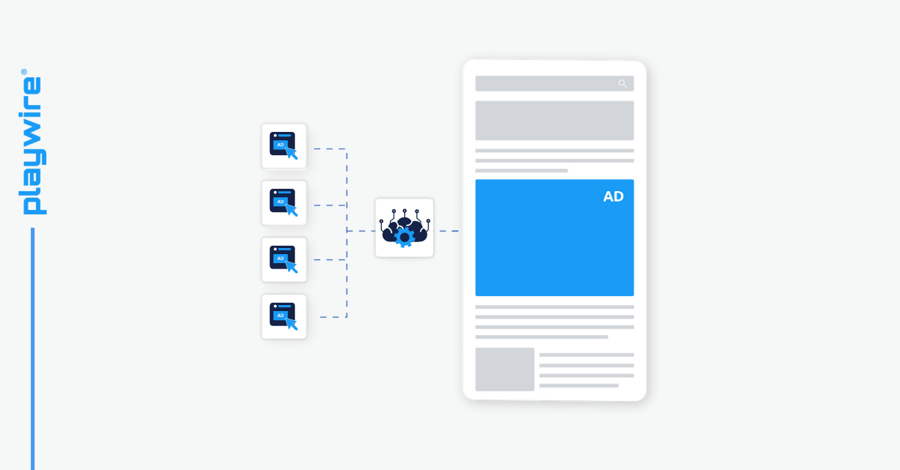
Key Points
- Historically, in-app ad monetization has not been publisher-friendly.
- Inefficiencies and roadblocks leave money on the table and make it difficult to manage integrations.
- Playwire is working to revolutionize the way in-app ad monetization is done. It’s all part of our top priority: prioritizing publisher needs.

The Complete Guide to App Monetization for Publishers
The Old Way
There are a lot of problems with the way app monetization has been historically executed, made possible primarily because of the sheer complexity of the ad tech supply chain.
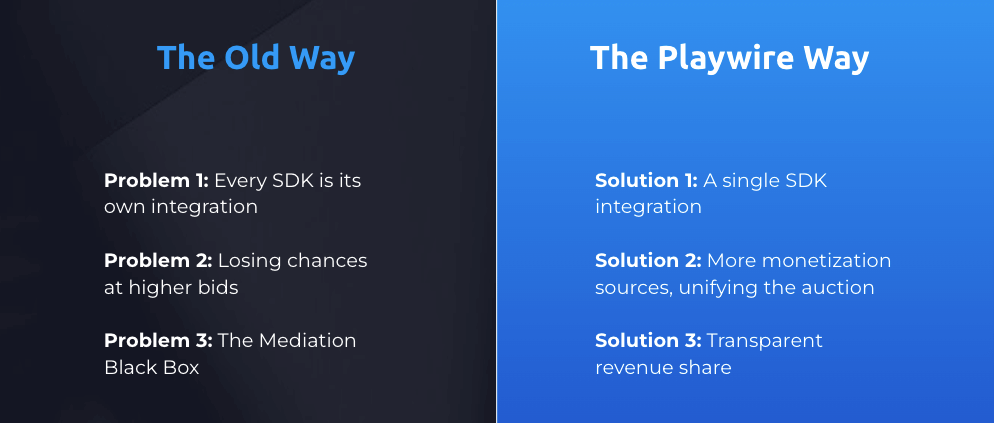
Problem 1: Every SDK Is Its Own Integration
Mediation partners provide ads to apps today. And every single mediation partner has their own SDK.
What does that mean for you? You have to devote precious time and development resources to integrating each mediation partner you would like to work with. Immediately, you may think: Why not just keep it simple and work with one? It’s a fair question, but if you want broad demand for your inventory, you have to work with more than one partner.
That’s because each partner brings their own unique demand — meaning unique buyers — to the table. Getting more buyers interested in your impressions means you can show more ads to more users more often and at higher prices.
But it also means you have to oversee and manage a ton of integrations, updates and new versions of your app. Every time one of those mediation partners you painstakingly integrated into your system does an update, you very likely will want to do the same.
Problem 2: Losing Chances at Higher Bids
The first problem is one of time, but this second problem is one of money. And when we’re talking about in-app ad monetization, that’s a big deal.
Here it is: Mediation partners are not designed to share bids from ad buyers; they only tell you whether there is a bid. The way they are designed, the ad server connected to them is forced to take a waterfall-style approach to requesting bids because mediation partners aren't passing any real-time bids along to the ad server.
So the best that an ad server can do is to guess at the likely value of any bid that you might get from the mediation partner, and to rank the partners accordingly in a waterfall-style call chain.
This waterfall chain starts with the partner who historically gives the highest average bids. You try that partner first and move down the list until someone issues an acceptable bid, and you take that. And that’s the best you can do.
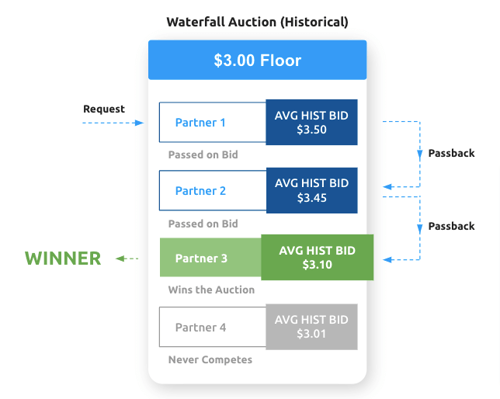
The problem? Just because the first bidder on the line has done high bids in the past does not mean they will bid high for any given ad request. That means you can end up with a lower bid from a bidder who is thought to be a big spender. You might have made more money had you continued down the waterfall auction line, but you would have no way of knowing that for sure.
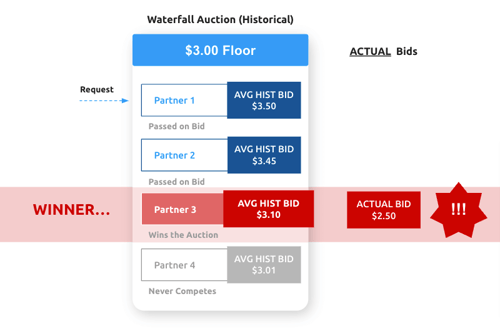
In other words, the old way leaves money on the table as a matter of routine. In some cases, such as in the example below, bidders who never got the auction call might have bid 50% more than the bidder who won the auction. This is by no means uncommon. In fact, it happens all the time.
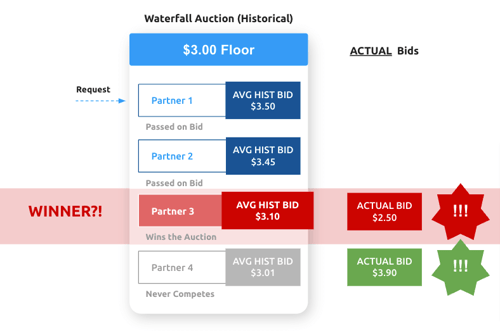
Problem 3: The Mediation Black Box
The third and final problem of the old way of doing in-app ad monetization is one of fairness. Mediation partners don’t pay publishers a fixed revenue share percentage. This model may be common, but it certainly doesn’t put the app publisher or developer needs first.
Why? Because there’s no real relationship between what the advertiser pays for your inventory and what you actually receive. We call it the mediation black box.
The mediation partner isn’t necessarily doing anything wrong, but they are taking a cut of the sale of your inventory that can vary a lot. They make more money if they buy your inventory for less and sell it for more. That means they are incentivized to secure less revenue per buy for you.
-- Article Continues Below --
The Complete Guide to Ad Monetization
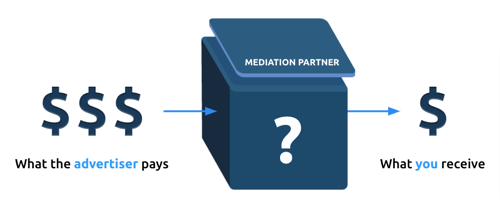
How Playwire and RAMP are Making Things Better
That’s a lot of problems. So, let’s talk about solutions. How is Playwire making in-app ad monetization better than the old way the app mediation partners still offer?
It starts with bridging the gap between monetization technologies in the web and mobile app spaces. Playwire is at the forefront of these technologies and practices in the app space. Here’s how:
Doing More with a Single SDK Integration
For years, getting higher CPMs in web publishing has been all about incorporating more sources of demand to drive higher competition. But competition has been woefully lacking in the app space. We’re changing that by adding more sources of demand to our mobile app SDK.
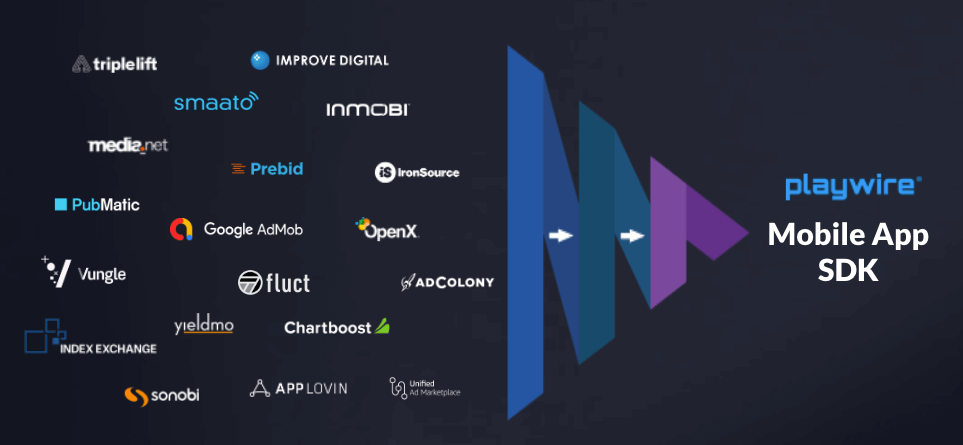
And we’re not just looking to the traditional demand sources available in the app space. We’re looking to new monetization sources that we can apply outside of the mediation sphere. For example, app publishers can now tap into SSPs that are leveraging decades of experience with web ads as they get their feet wet in apps.
We’re working with Prebid, Google Open Bidding, Amazon Transparent Ad Marketplace (TAM), and more. What’s important is that we get to see the actual bids from these sources. That insight allows us to build a unified and open auction, which even includes direct-sourced demand from our direct sales team. Here’s what that means for you:
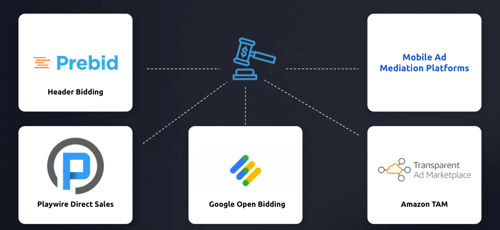
Your app gets different kinds of ads from the new sources (TAM, Prebid, Open Bidding, etc.) we incorporate into our SDK. The mediation partners have a virtually endless supply of user acquisition (UA) ads. With UA ads, you get paid when a user sees the ad and completes an action — usually downloading the advertised app.
The newer ads — the ones you get with Playwire — are less about performance and more about branding. That means you get paid when the ads reach user eyeballs. That’s a much lower barrier to revenue.
All of that is to say that we are not simply adding pipes to connect you to the same pool of buyers. With our mobile SDK, you reach a fundamentally different type of buyer.
Unifying the Auction
In Playwire’s version of in-app ad monetization, auctions are unified. Our in-app header bidding solutions create a unified auction between the majority of our demand sources. That unified auction creates real competition, in which each bidder has no idea what the other has bid, and the best bid wins.
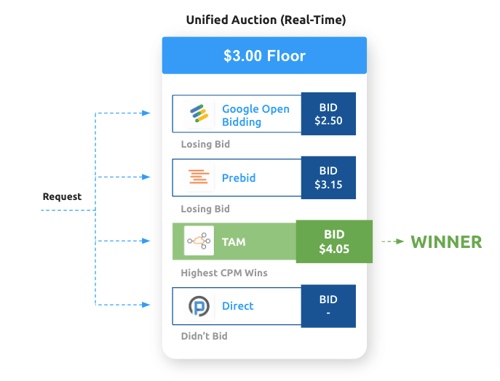
But we take that even further. Because we’re incorporating demand from so many sources, we get the best bids from each of the best header bidding demand sources, and all of those elite bids compete for your inventory. That means that, behind the scenes, each header bidder in your stack has already run an auction and selected the highest bid inside their network. That means higher CPMs for you — plain and simple.
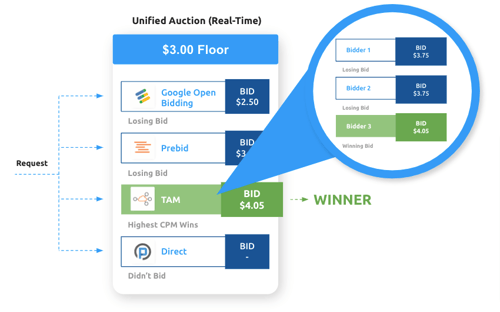
Driving More Competition Between Mediation Partners
This isn’t to suggest that we completely bypass mediation partners in our mobile ads SDK. In fact, mediation partners are a critically important part of the ecosystem. We just want them to have more competition.
And that’s how we have engineered it to be: We have mediation partners compete with header bidders for each auction. We take the best bid from the header bidder auction and compare it to the bids we get from the mediation waterfall. The best bid of the bunch wins.
.png?width=600&name=App-Mediation-Partners_In-App-Header-Bidding%20(1).png)
Providing Transparent Revenue Share
There’s no mediation black box when you work with Playwire. We put publisher needs first, and the numbers bear that out. That’s why we aren’t afraid of adopting a fair and transparent revenue share model.
Instead of paying you whatever we want and reselling your inventory for a huge profit, we take an agreed-upon percentage of the revenue you earn on your inventory. That way, you see the direct relationship between what the buyer is paying and what you’re making, and we are incentivized to secure higher bids on each and every impression.
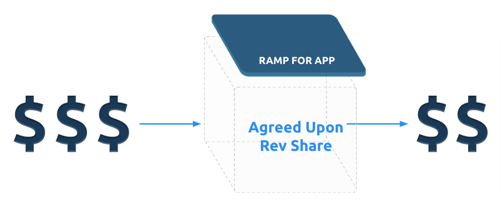
Simplifying Integration and Maintenance
Demand sources aren’t static. They change — new players enter the scene, others diminish in importance. To truly maximize your app revenue, you need to be able to integrate new demand sources without having to hire more developers.
That’s why we have simplified SDK integration and maintenance. With our single SDK, we can add new sources of demand without you having to execute a completely new integration. That’s time, money and headaches saved in the name of ensuring your revenue is at its absolute maximum at all times.
Incorporating Direct Sales
This conversation would be incomplete without a discussion of our direct sales capabilities. Playwire maintains a global direct sales team that works with some of the biggest brands in the world. And we don’t just reserve that demand for desktop publishers. We incorporate it into our in-app ad monetization.
More specifically, we have header bidders’ and mediation partners’ bids compete with direct demand we have generated for you. Why does this matter? Because direct sales, in almost every case, mean higher CPMs. And that’s what you’re here for.
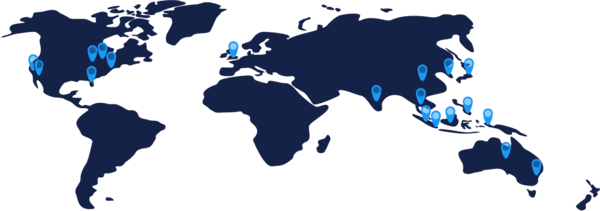
Using Revenue Intelligence to Maximize CPMs
We have also invested an enormous amount of time, effort and money into building AI- and machine learning-based systems that are revolutionizing in-app monetization. We call it Revenue Intelligence, and it is already changing the game for publishers. Learn more about it here.
The Complete App Monetization Resource Center
Managing More of the Details
So far, we have covered a lot of moving parts. One of the additional — and most important — ways we are changing the face of in-app monetization is managing all of those moving parts for you. It only sounds small until you start to dig into all of it on your own.
It’s more than a full-time job — it’s the job of several people, and most publishers simply don’t have the resources to do it all on their own. And with Playwire, they don't have to. Our team manages implementation, data, sales, ad unit development and so much more so you can focus on building your audience.
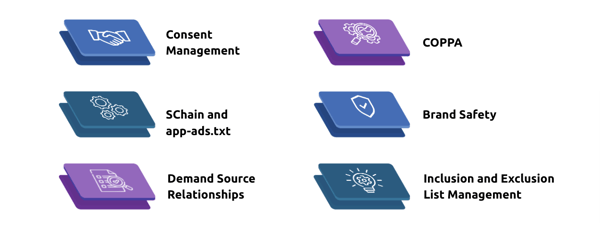
Offering More Innovative Ad Units
We don’t just innovate on the back end of app monetization. We also innovate for app publishers on the very visible front end by creating premium ad units that you can’t find anywhere else.
For example, custom gamified units or units built into the gameplay of an app can drive considerable interactivity.
Additionally, our rewarded video units offer app users clear value, and that translates to unmatched ad performance metrics that big brands are dying to get their hands on. With this unit, the user engages the video ad with the understanding that they will get an in-app reward of some kind, such as an extra life or exclusive in-game item, for completing it.
Meanwhile, our in-app interstitials boast a 2.5% CTR and a 3% to 4% engagement rate. And our cross-platform flex leaderboards — with 100% viewability, 1.5% engagement and 80% video completion rates — work brilliantly on mobile devices.
You can learn more about our innovative mobile ad units here.
Our Belief: In-App Ad Monetization Should Be Better for Publishers
App publishers deserve results and fairness in monetization. You work hard to create incredible content and engage your audience. You shouldn’t have to struggle while third parties take large chunks out of your margins for your hard-earned impressions.
We’re working hard to make sure you never have to. To do that, we’re changing the face of in-app ad monetization for the better: transparent revenue share, a single SDK, more and different demand sources, AI-powered revenue optimization and innovative ad units are just the start.
This is an exciting time — in-app ad monetization is changing, and we’re putting our publishers at the forefront. Want to be a part of it? Contact us.

-1.png?width=800&height=157&name=1-playwire-logo-primary-2021%20(1)-1.png)





